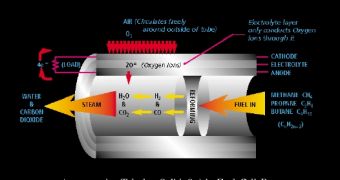Acumentrics Corporation announced today that it will exhibit a new, fuel cell powered, home energy appliance (micro-CHP) at the Hannover Fair this April in Hannover, Germany.
Cogeneration (combined heat and power or CHP) is the use of a heat engine or a power station to simultaneously generate both electricity and useful heat.
Conventional power plants emit the heat created as a byproduct of electricity generation into the environment through cooling towers, as flue gas, or by other means. CHP captures the byproduct heat for domestic or industrial heating purposes, either very close to the plant, or - especially in Scandinavia and Eastern Europe - for distribution through pipes to heat local housing (district heating).
"With rising fuel costs and safety concerns in both the military and homeland security, it was a natural fit with our existing business in rugged uninterruptible power supplies (Rugged UPS), which are sold primarily to the military, [and] we recognized that there was a need for remote clean power where the alternatives were noisy, unreliable and low in efficiency", said Norman Bessette, senior vice president of engineering and CTO.
The fuel cell consists of a tube of catalytic ceramic. Room air flows around the outside of a tube, and fuel (methane, propane, biofuels, hydrogen) is passed through the inside of the tube. The high concentration of oxygen on the outside of the tube, combined with the low concentration of oxygen on the inside of the tube, causes the oxygen to diffuse through ceramic.
As oxygen ions pass through the tube wall, they create an electrical current, because each oxygen ion carries two electrons. When the oxygen arrives at the inside of the tube, it combines with the inner fuel to create carbon dioxide and water.
The eco-friendly fuel cell simultaneously creates electricity, converts noxious gases such as methane into carbon dioxide and water that are heated up to 800 degrees C (1472 F) from the controlled combustion of oxygen.
The electricity is captured for power, and because they are twice as efficient as traditional generators, they halve the production of green house gases, like nitrogen oxide (NO) and sulfur oxides (SO, SO2 and SO3) and can restrain carbon dioxide emissions, and the excess heat can be used for combined heat and power applications, like home heating or refrigeration, with a total efficiency of up to 90%.
At last, some good news for the environment! We can only hope that more environmental friendly applications emerge, for the benefit of all humankind.

 14 DAY TRIAL //
14 DAY TRIAL //